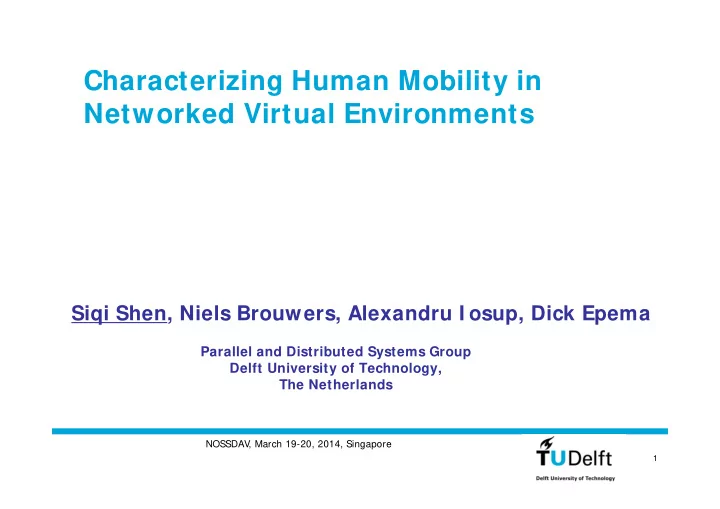

Characterizing Human Mobility in Networked Virtual Environments Siqi Shen, Niels Brouwers, Alexandru I osup, Dick Epema Parallel and Distributed Systems Group Delft University of Technology, The Netherlands NOSSDAV , March 19-20, 2014, Singapore 1
Motivation 1/ 2 Understanding the avatar mobility patterns in Networked • Virtual Environments (NVEs) • To tune existing designs of NVEs 1. Pre-fetching of NVE media contents according to movement NOSSDAV , March 19-20, 2014, Singapore 2
Motivation 1/ 2 Understanding the avatar mobility patterns in NVE • • To tune existing designs of NVEs 1. Pre-fetching of NVE media contents according to movement 2. Load balancing of workloads NOSSDAV , March 19-20, 2014, Singapore 3
Motivation 1/ 2 Understanding the avatar mobility patterns in NVE • • To tune existing designs of NVEs 1. Pre-fetching of NVE media contents according to movement 2. Load balancing of workloads 3. Resource leasing from cloud according to workloads NOSSDAV , March 19-20, 2014, Singapore 4
Motivation 1/ 2 Understanding the avatar mobility patterns in NVE • • To tune existing designs of NVEs 1. Pre-fetching of NVE media contents according to movement 2. Load balancing of workloads 3. Resource leasing from cloud according to workloads • To innovate future design • Question : How similar are World of Warcraft and Second Life avatar mobility patterns? NOSSDAV , March 19-20, 2014, Singapore 5
Motivation 2/ 2 Increasing number of location • based virtual environments Map Attack Pac Man Manhattan • The real-world mobility affects the performance of NVEs The picture of Pac man from http://pacmanhattan.com/index.php Original picture of map attack from https://geoloqi.com/blog/2011/09/building-a-real-time-location- 6 based-urban-geofencing-game-with-socket-io-redis-node-js-and-sinatra-synchrony/
Motivation 2/ 2 Comparing the avatar mobility patterns with real-world • human mobility patterns Using the methods dealing with human mobility in real world • to manage virtual world? Using the mobility models developed in real-world? • • Question: How similar are the characteristics of mobility in virtual and real world? NOSSDAV , March 19-20, 2014, Singapore 7
Agenda Datasets • Characterization • Implication and Limitation • Conclusion • NOSSDAV , March 19-20, 2014, Singapore 8
Data Collection from Virtual world Using bots to read anonymized avatars’ positions from • different cities of World of Warcraft (WoW). 3 capital cities: StormwindCity, Ironforge, Orgrimmar • from a normal playing sever StormwindCity from a role playing server. • NOSSDAV , March 19-20, 2014, Singapore 9
Data acquired from real/ virtual world 31,290 World of Warcraft avatars. • 26,714 Second-Life avatars. Liang et al. 2009 (NUS) • 4 zones: Isis, Pharm, Ross, Freebies • 1,366 persons’ GPS positions. Bohte and Maat 2009 • (TUDelft) 52 persons’ GPS positions. Rhee et al. 2008, (NCSU • and KAIST) NOSSDAV , March 19-20, 2014, Singapore 10
Agenda Datasets • Characterization • Implication and Limitation • Conclusion • NOSSDAV , March 19-21, 2014, Singapore 11
Long-tail distributed flight length Flight: a straight line trip without pause or significant • directional change. Most of the flights are shorter than the Area-of-Interest (AoI) • range NOSSDAV , March 19-20, 2014, Singapore 12
The distribution fitting of flight lengths: WoW vs GPS We fit the flight lengths against different distributions • The flight lengths distributions for the two GPS datasets are • longer than the two virtual world datasets NOSSDAV , March 19-20, 2014, Singapore 13
Long-tail distributed pause duration Pause duration: the time duration an individual does not move • 80% of the pause durations of WoW is shorter than 30 seconds • 80% of the pause durations of SL is shorter than 100 seconds • NOSSDAV , March 19-20, 2014, Singapore 14
The distribution fitting of pause durations: WoW vs GPS The pause duration of the GPS dataset are longer than the • virtual world data NOSSDAV , March 19-20, 2014, Singapore 15
Area popularity A person visited an area only if the person pauses at that • area The area popularity of virtual world is skewed • NOSSDAV , March 19-20, 2014, Singapore 16
Limited number of visited areas Avatars/persons only visit a small set of the studied maps • invisible movement boundary is present in both real and • virtual worlds. NOSSDAV , March 19-20, 2014, Singapore 17
Personal preference in area visitation The Gini coefficient is used to quantify the inequality of • personal preference The probability of a user to visit a given area is skewed • NOSSDAV , March 19-20, 2014, Singapore 18
Agenda Datasets • Characterization • Implication and Limitation • Conclusion • NOSSDAV , March 19-20, 2014, Singapore 19
I mplication Skewed area popularity • • Caching of video/textures • Zone partitioning and load-balancing Peer-to-Peer NVE • • Pick super nodes based on the personal preference or pause duration • Preference in area visitations: sharing rendered images among avatars NOSSDAV , March 19-20, 2014, Singapore 20
Limitations Bots • City scenarios vs fighting scenarios • Client side dataset collection • • Coverage: temporal and spatial • Small scale NOSSDAV , March 19-20, 2014, Singapore 21
Conclusion Long-tail distribution of flight lengths and pause durations • Skewed popularity of areas • Avatars only travel small parts of the virtual cities • Different personal preferences for areas • For GPS, the flight length is longer; and the personal • preference to some areas is higher NOSSDAV , March 19-21, 2014, Singapore 22
Thanks for listening. • Any questions, comments, suggestions? • Siqi Shen S.Shen@tudelft.nl • http://www.pds.ewi.tudelft.nl/~ siqi/ • Data available at Game Trace Archive • http://www.pds.ewi.tudelft.nl/~ siqi/mobility/main.htm http://gta.st.ewi.tudelft.nl/ NOSSDAV , March 19-20, 2014, Singapore 23
Recommend
More recommend